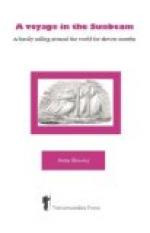Wednesday, February 7th.—A misty but much warmer morning succeeded a wet night. At 8.30 Sir Harry Parkes and two other gentlemen arrived, and we all started at once in jinrikishas to see what could be seen in the limited time at our disposal. We went first to the temple of Gion Chiosiu, described elaborately in books by other travellers. It is specially interesting to Europeans, as it was the temple assigned to the foreign envoys when they paid their first visit to the Mikado in 1868. Sir Harry Parkes showed us all their apartments, and the large though subsidiary temple once used as a hospital, and we afterwards went to see the service performed in the temple. A dozen bonzes, or priests, were sitting round in a circle, chanting monotonously from ponderous volumes, with an occasional accompaniment from a gong or drum. Incense was being burned, vestments worn, processions formed, and prayers offered to Buddha to intercede with the Supreme Being. The accessories and surroundings were of course different, but the ceremonial struck me as being much the same as that in use at Roman Catholic places of worship. Mr. Simpson, however, thinks differently. He says:
’I was only a month in Japan, and that is far too short a time for anything like serious study; but I was much struck by the temples, and I find I have some notes in my book comparing them with the Jewish. How any direct connection could possibly exist, is far beyond my powers of conjecture; but I will state the points of resemblance, and leave others to inquire further and collect additional information. Wood and bronze to this day furnish the material of which temples are constructed in Japan, with stone as a base. Such also were the materials of Solomon’s temple. There are enclosures round each court or shrine, and sometimes these courts are three in number. Hills or groves are usually sites for a temple, the ascent to which is by a long flight of steps; usually two flights give access to the shrine. One is long, straight, and steep, for the men; the other, less steep, but curved, is for the women. It will be remembered that it was the great stairs at Solomon’s temple that so impressed the Queen of Sheba. Small shrines or miniature temples, called Tenno Samma, or “Heaven’s Lord,” are carried on staves, like the Ark of the Covenant, at their religious ceremonies. The inner shrine, or Holy of Holies, is small, and a cube, or nearly so, in proportion. It is usually detached behind the other portions of the temple, the door being closed, so that it cannot be seen into, and it generally contains, not an image, but a tablet, or what the Japanese call a “Gohei,” or piece of paper, cut so that it hangs down in folds on each side. In the early days of writing, a tablet was a book, a stylus the pen. The stone on which the law was inscribed was only a form of the book, and the Chinese ancestral tablet, or other tablet, in a temple, is only a variety of this book form. These “Goheis”




